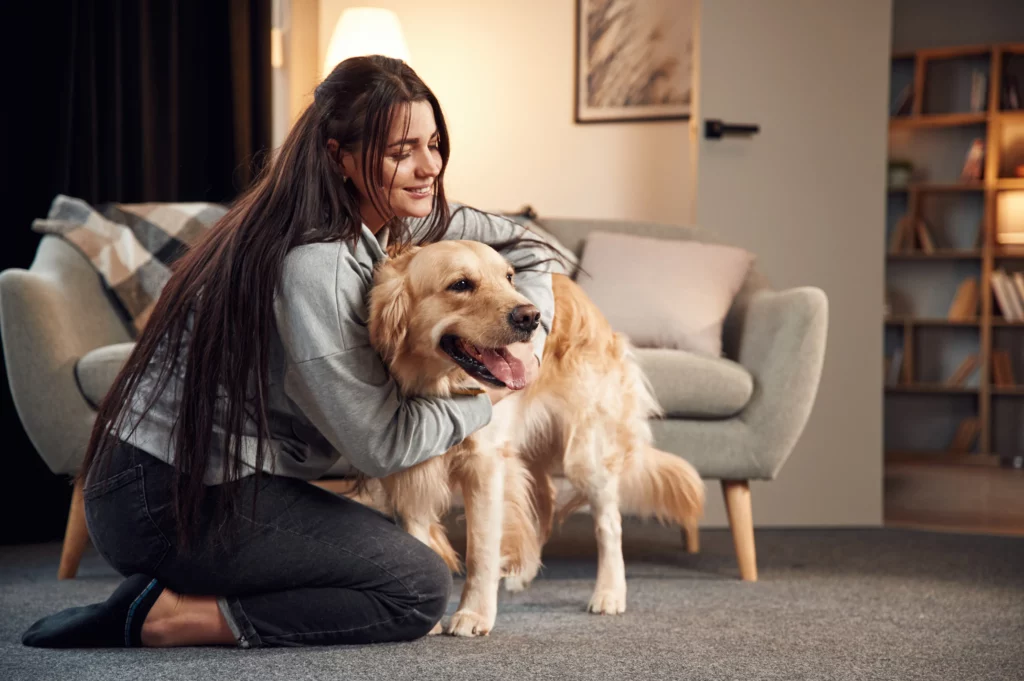
Many dog owners are unaware of a secret that can transform your playful pup into the happiest hound on the block.
What's the magic formula, you may wonder? Well, it's simpler than you might think - proper daily care. Daily care for dogs is not just about fulfilling the basics like feeding and walking; it's about nurturing a bond of love, understanding, and mutual respect with your furry friend.
By embracing a routine that caters to their physical, mental, and social needs, you pave the way for their all-round well-being. After all, a cared dog is not just a happier dog but a healthier and more balanced one.
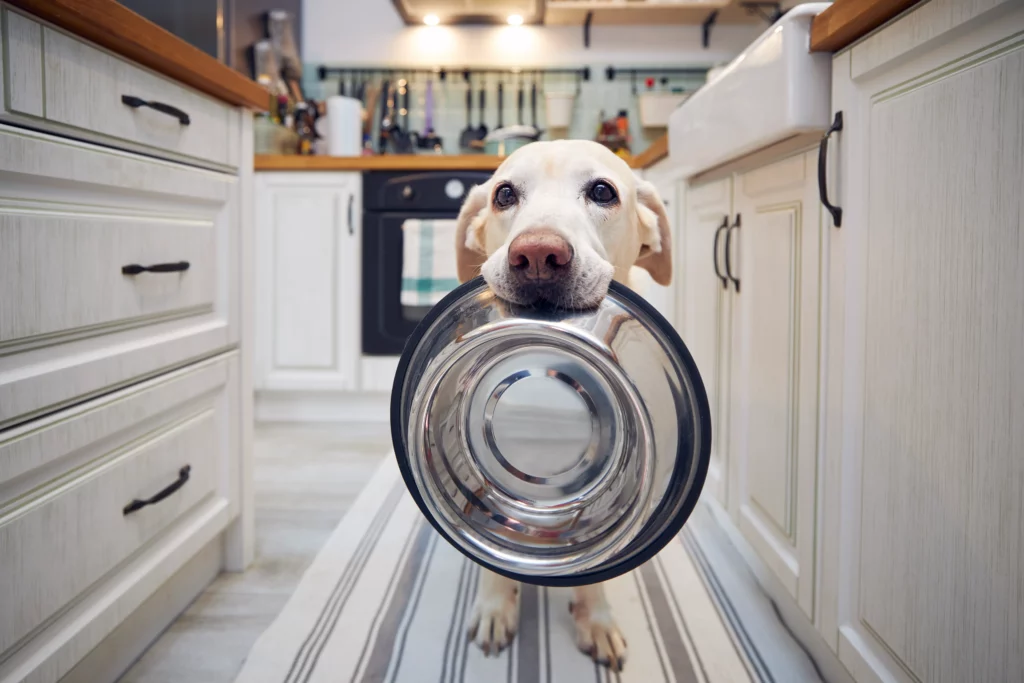
Balanced nutrition plays a significant role in your dog's overall happiness.
A diet packed with vital nutrients maintains your dog's physical health and impacts their mood and energy levels. Nutrition deficiencies can lead to lethargy, mood swings, and even depression in dogs, while a balanced diet can foster vitality, good temperament, and overall welfare.
Choosing the right dog food can be daunting for pet owners, given the variety of brands and diets available in the market. The key is to look for dog food high in animal protein, has the right balance of fats and carbohydrates, and is free from artificial additives.
Consider your dog's age, breed, activity level, and any existing health conditions while choosing. There are some foods that you absolutely can't give your dog, here is a list of them.
Regular feeding is critical for your dog's digestive health and happiness since it ensures that your dog gets the necessary nutrition and provides structure to your dog's day.
While treats and snacks can be an effective training aid and a way to show affection, it's crucial to maintain a balance.
Excessive treatment can lead to weight gain and nutritional imbalances.
Opt for healthier options like carrots or apple slices; remember, treats should make up no more than 10% of your dog's daily caloric intake.
Regular physical activity helps to maintain your dog's ideal body weight, lowers the risk of developing certain diseases, and promotes cardiovascular health.
Beyond these physical benefits, exercise contributes to your dog's happiness by reducing stress and anxiety, improving mood, and fostering better sleep.
Different dog breeds have different exercise needs.
While Border Collies and Huskies thrive on high-energy activities, smaller or brachycephalic breeds like Bulldogs or Pugs require less intense and more frequent short bouts of exercise.
Tailoring your dog's exercise routine to their breed's specific needs is essential to avoid overexertion and ensure a beneficial exercise regime.
Staying physically active doesn't necessarily mean sticking to the same daily routine.
You can introduce creative ways to keep your dog active, like agility training, swimming, or dog yoga (dog yoga).
Taking your dog for a hike or a run on the beach can also provide a change of scenery and add an element of excitement to their exercise routine. Remember, an active dog is a happy dog!
Taking Your Dog to the Beach: 4 Easy Tips You Should Follow
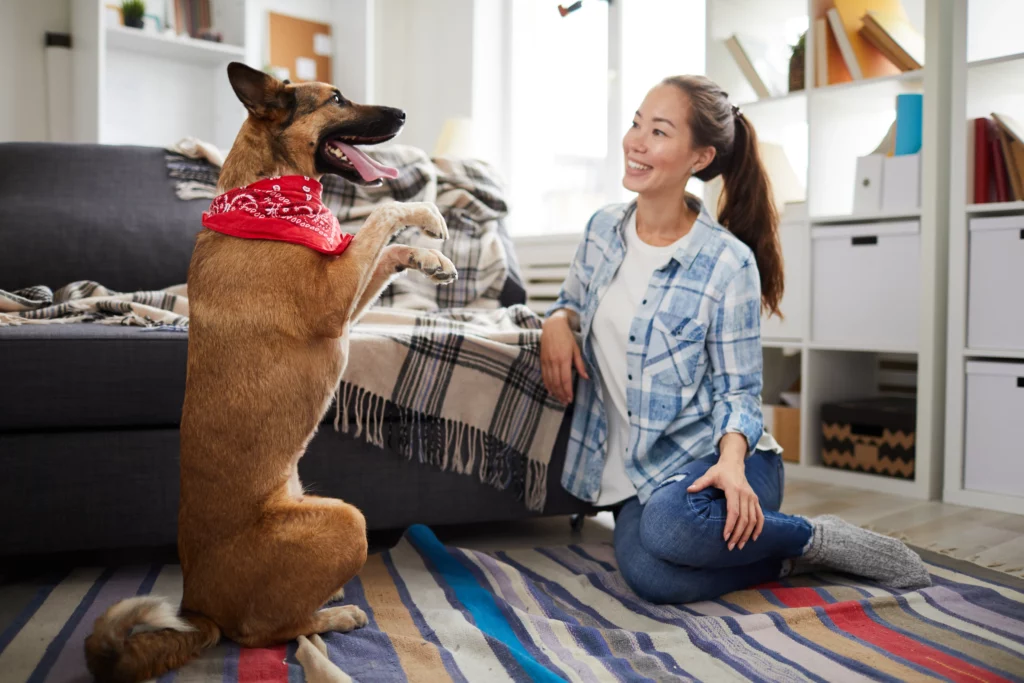
Mental stimulation is equally important in maintaining your dog's cognitive welfare. Mental stimulation challenges your dog's brain to think, learn, and problem-solve. It boosts intelligence and memory, wards off boredom, reduces destructive behaviors, and promotes happiness.
Interactive toys and games are great tools for providing mental stimulation. Puzzle toys, treat-dispensing toys, or toys that require problem-solving can keep your dog mentally engaged for hours.
Similarly, playing games like hide-and-seek or fetch stimulate your dog's natural instincts to hunt and retrieve, keeping their minds sharp and active.
Training tasks require concentration and problem-solving abilities, whether teaching basic commands, practicing obedience, or learning new tricks. These sessions help improve your dog's cognitive health and strengthen the bond between you and your pet, contributing to their emotional well-being.
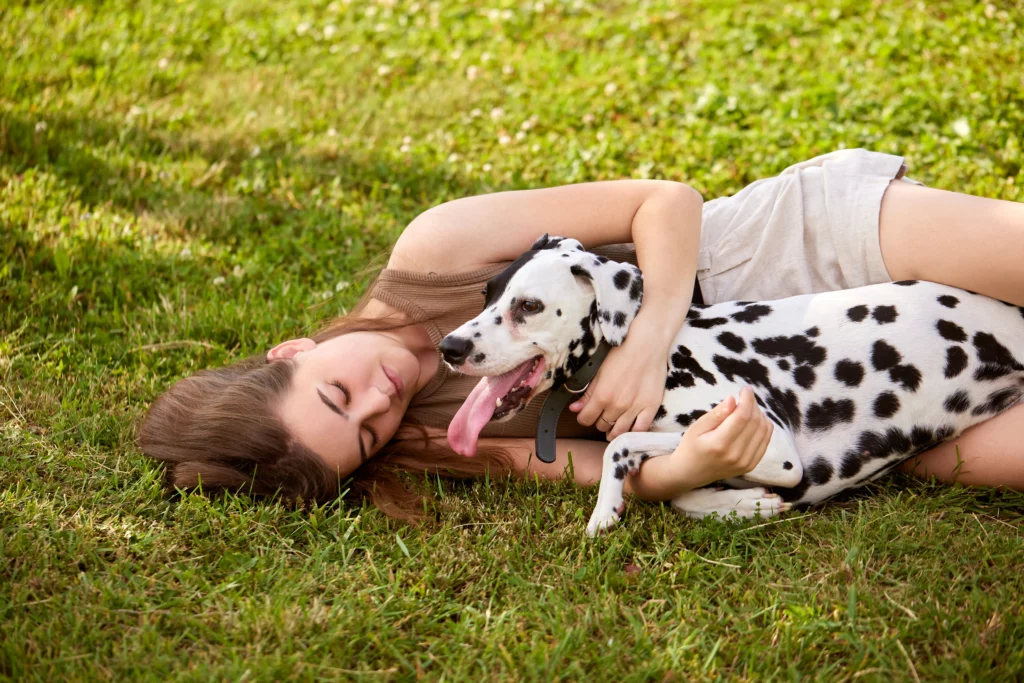
Proper grooming helps your dog look its best and promotes physical health by preventing skin conditions, parasites, and infections.
Moreover, grooming sessions allow you and your dog to bond, reinforcing trust and affection, essential elements of canine happiness.
Need tips? 6 Easy Steps For Dog Grooming at Home
Brushing your dog's coat helps to remove dead hair, dandruff, and dirt, thus promoting a healthier coat and reducing the chance of skin irritation.
Preferably with a dog-friendly shampoo, bathing helps keep your dog's coat clean and free from parasites.
Remember, the frequency of baths will depend on your dog's breed and lifestyle. Always dry your dog thoroughly after a bath to prevent any skin issues.
Find helpful information: The Best Skin and Coat Conditioner For Dogs
Nail trimming helps maintain your dog's comfort and mobility. Long or sharp nails can cause pain and injury, affecting your dog's happiness. Likewise, regular ear cleaning prevents ear wax buildup, reduces the chance of ear infections, and contributes to your dog's overall comfort.
Regular health check-ups help in the early detection of potential health issues, ensuring that your dog gets the appropriate care and treatment in time.
Vaccinations, screenings, and dental care are all parts of preventive healthcare that contribute to your dog's long-term happiness.
Our furry friends are incredibly social creatures who thrive on companionship.
They view us as their pack, and strong bonds with their human family members provide a sense of security and comfort.
A robust human-canine bond fosters trust builds confidence in your dog and significantly contributes to their overall happiness.
Mental Health and Pets - 3 Best Pets for Mental Health
Incorporating quality time with your dog into your daily routine doesn't have to be time-consuming or complicated.
Cuddling on the couch, playing together, or talking to your dog can help foster this bond. Including your dog in everyday activities, like watching TV, gardening, or cooking, can also provide opportunities for bonding.
The crucial aspect is to ensure that your dog feels included and loved.
Every dog is unique, with their own set of needs and preferences. Knowing your dog's likes and dislikes, comfort zones, and triggers is critical to building a solid bond and promoting happiness.
Whether your dog enjoys long walks, a game of fetch, or simply lounging by your side, catering to their preferences during your time together will enhance their joy and contentment.
Dogs are highly receptive to our emotions and behavior. They respond positively to affectionate, calm, and positive behavior, leading to a happier and more relaxed state of mind.
Consistent positive interaction strengthens the human-canine bond, promotes better behavior, and enhances overall canine happiness.
Your dog will multiply the happiness you give them, fostering a harmonious and joy-filled living environment.
Daily Care for dogs needs involves more than feeding them.
It encompasses a holistic approach that includes regular physical activity, mental stimulation, grooming and hygiene practices, quality time, and bonding.
Regular exercise helps maintain physical health, while mental exercise enhances cognitive well-being.
As pet owners, it's essential to prioritize the happiness and well-being of our furry friends. They bring us so much joy and unconditional love; we are responsible for reciprocating that by providing them with the best care possible.
Investing effort in your dog's daily care will reward you with a loyal, loving companion and a meaningful, joy-filled relationship.

Skin rash on dogs is a common issue that dog owners face routinely. Estimates suggest that nearly one in five dogs will experience some form of skin allergies or rash in their lifetime.
These skin issues are not just uncomfortable for your canine companions, but they can also be indicative of more severe health problems if left untreated.
In this article, we will run you through three essential steps to help you tackle skin rash on dogs: recognizing the signs, seeking professional advice, and adhering to ongoing preventative measures.
Let's dive into these steps to ensure your furry friend stays happy and healthy!
First, it's crucial to identify the root cause of your dog's skin rash to tackle the problem.
For instance, treating a skin rash caused by an allergy with anti-parasite medication won't work. Once the root cause is known, proper treatment can alleviate symptoms and address the underlying problem.
Let's look at some of the most common triggers:
Learn: 6 Alarming Symptoms of itchy skin in dogs
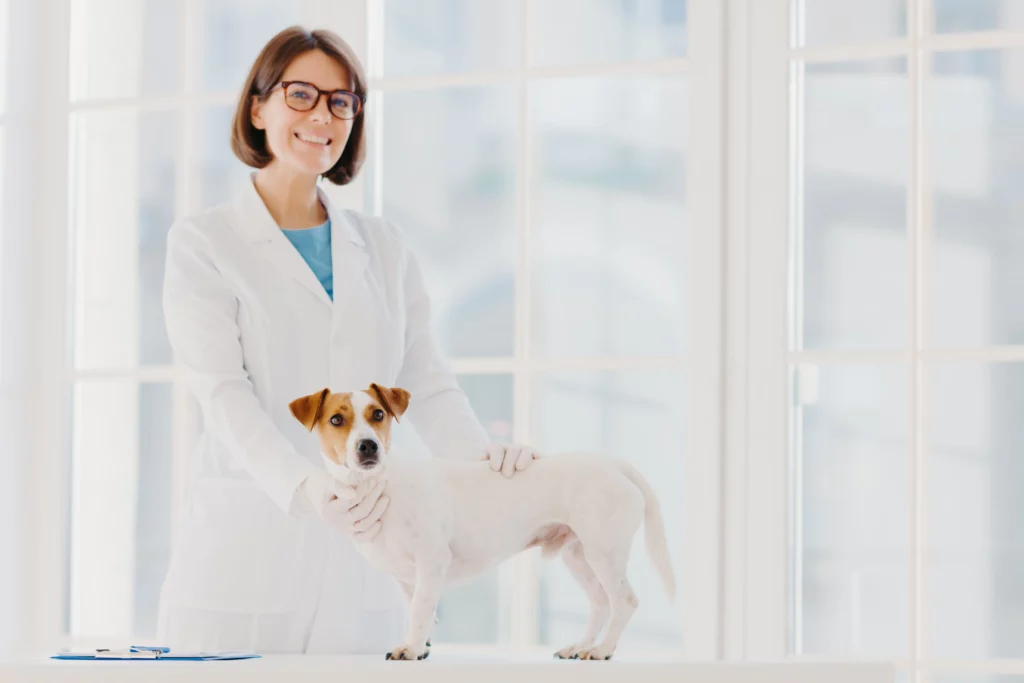
A veterinarian can detect early signs of skin issues, identify potential allergens or parasitic infestations, and provide necessary vaccinations to prevent bacterial or fungal infections.
Regular check-ups also present an opportunity to discuss your dog's diet and environmental factors that could cause skin problems.
Hypoallergenic shampoos are a good choice for dogs with sensitive skin or allergies. If your dog has dry skin, consider a moisturizing shampoo.
Bathing your dog with a dog-friendly shampoo will keep your pet tidy and smelling pleasant and help manage skin conditions and relieve irritations.
Always avoid human shampoos, as they can disrupt the natural pH balance of your dog's skin and cause irritation.
Related: 6 Environmental Allergies in Dogs
The number of baths will depend on your dog's breed, lifestyle, and skin condition.
Generally, a monthly bath is sufficient for most dogs, but dogs with skin conditions or who spend much time outdoors might need more frequent baths.
Always consult your vet to determine the best bathing routine for your dog.
Discover The Best Skin and Coat Conditioner for Dogs
Regular brushing helps distribute natural oils, removes loose fur, and prevents matting. Brushing also allows you to check your pet's skin for signs of rashes, parasites, or infections.
Read: 6 Easy Steps For Dog Grooming at Home
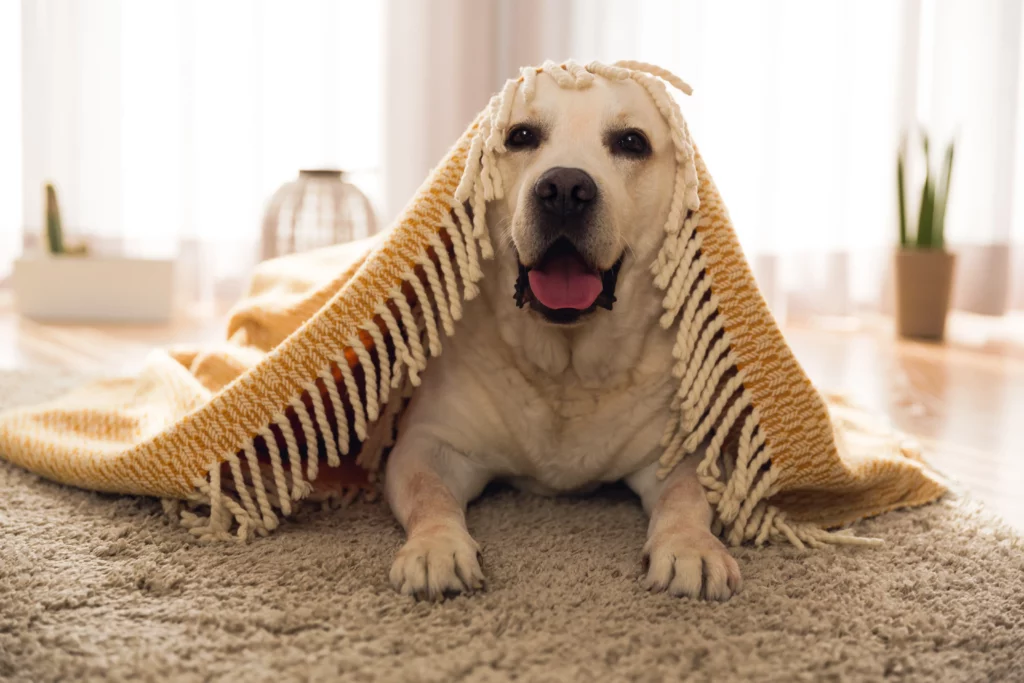
A clean living environment contributes to overall skin health and can help prevent skin rash on dogs.
Washing Bedding and Toys: Regular washing of your dog's bedding and toys can remove allergens and parasites that may cause skin irritation. Use a pet-friendly detergent and make sure everything is thoroughly dried to prevent mildew.
Vacuuming and Cleaning Common Areas: Keeping the areas where your dog frequently spends time clean is also important. Regular vacuuming can reduce the presence of allergens and parasites in your home. Use pet-friendly cleaning products to avoid causing skin rashes and irritation.
An adequate, balanced diet can help nourish your dog's skin from the inside out, fortifying it against environmental aggressors and internal imbalances that can lead to skin rashes and other issues. Conversely, a poor diet lacking essential nutrients can lead to a dull coat, dry skin, and various dermatological problems.
Omega-3 fatty acids, commonly found in fish and flaxseeds, offer significant skin benefits for dogs. They have anti-inflammatory properties, which can help alleviate skin redness, itchiness, and swelling associated with rashes. Incorporating this essential fatty acid in your dog's diet can promote a glossy coat and healthy skin.
Protein aids tissue repair and maintenance, crucial for dogs suffering from rashes or other skin conditions. High-quality protein sources such as chicken, beef, fish, and eggs can provide this essential nutrient.
Hydration maintains skin elasticity and prevents dryness, which can lead to itching and skin rash on dogs. Ensuring your pet friend has constant access to fresh, clean water is a simple yet effective way to support their skin health.
While these general guidelines can be beneficial, it's crucial to remember that each dog has unique nutritional needs. That's why consulting with a veterinarian is invaluable for getting personalized dietary advice.
A vet can make specific diet recommendations based on your dog's breed, age, size, and overall health, helping you choose the best food and supplements to maintain healthy skin and coat.
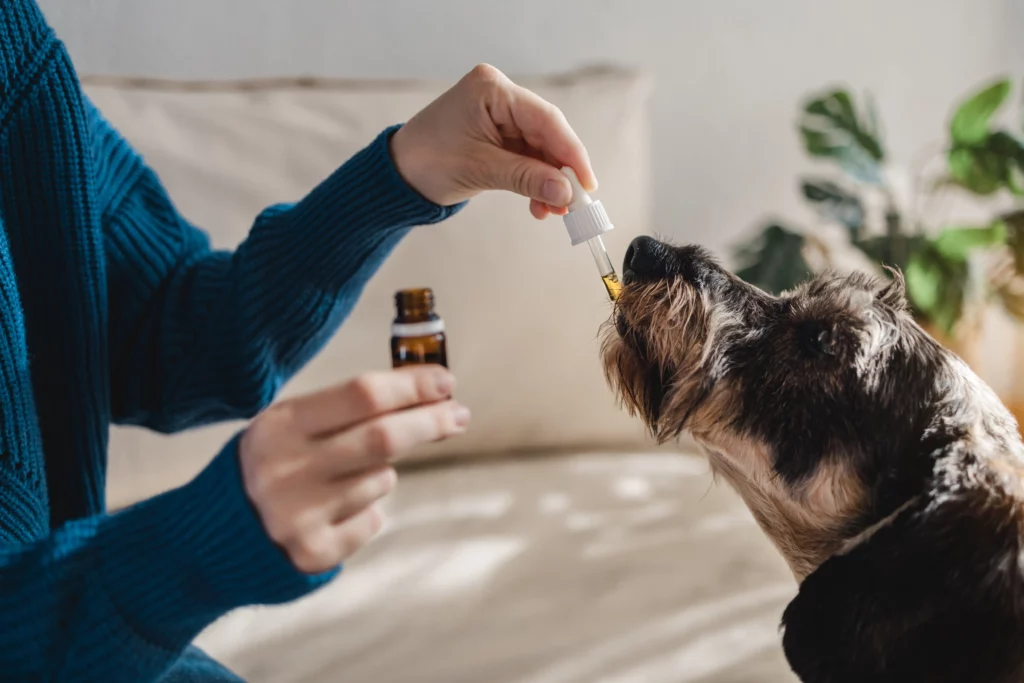
Once veterinarians identify the cause of your dog's skin rash, they can initiate targeted treatment, which may involve over-the-counter treatments, prescription medications, home remedies, or a combination of these approaches.
Antihistamines and topical creams, available over-the-counter (OTC), can relieve common skin rashes by treating symptoms such as itching, redness, and swelling.
Remember, seeking veterinary advice before applying any OTC product is essential to ensure it's safe and suitable for your pet's condition.
In milder cases or as an adjunctive treatment, specific home remedies can be beneficial.
Aloe Vera and Oatmeal Baths
A bath with a shampoo containing aloe vera and oatmeal can help alleviate your dog's discomfort due to these’s natural soothing and healing properties.
Coconut Oil for Moisturizing
Applying coconut oil to your dog's skin can help alleviate dryness and flaking associated with skin rash on dogs.
Herbal Remedies like Chamomile for Soothing Effects
Chamomile can have calming effects on irritated skin. A chamomile tea rinse or a poultice can be a soothing treatment option for your dog's skin rash.
Your vet may prescribe medication to treat your dog's skin rash in more severe cases. It could include antibiotics for bacterial infections, antifungal medications for fungal rashes, or steroids for painful inflammatory conditions.
Always follow your vet's instructions for dosage and duration of treatment to ensure the effectiveness of the medicine and prevent potential side effects.
AniViva® Animal Health Serum is a specially formulated cosmetic skin conditioner and moisturizer designed to promote your pet's health. Enriched with a concentrated blend of Zinc, Copper, and Magnesium, this unique serum comes in a convenient spray pump bottle.
Suitable for a range of pets, including cats, dogs, horses, and other animals, AniViva® Animal Health Serum is a topical nutritional aid that can significantly enhance your pet's overall health. It mainly benefits their coat health and can efficiently address skin rash issues.
What sets AniViva® Animal Health Serum apart is its environmentally friendly formula. Free of oil and alcohol, minimizing the chance of skin irritation.
Regardless of the treatment method chosen, it's crucial to follow dosage instructions and consult a vet regularly. Overdosing or underdosing can lead to ineffective treatment or unwanted side effects.
Consulting your vet ensures that they safely, appropriately, and effectively monitor the treatment for your dog's skin rash.
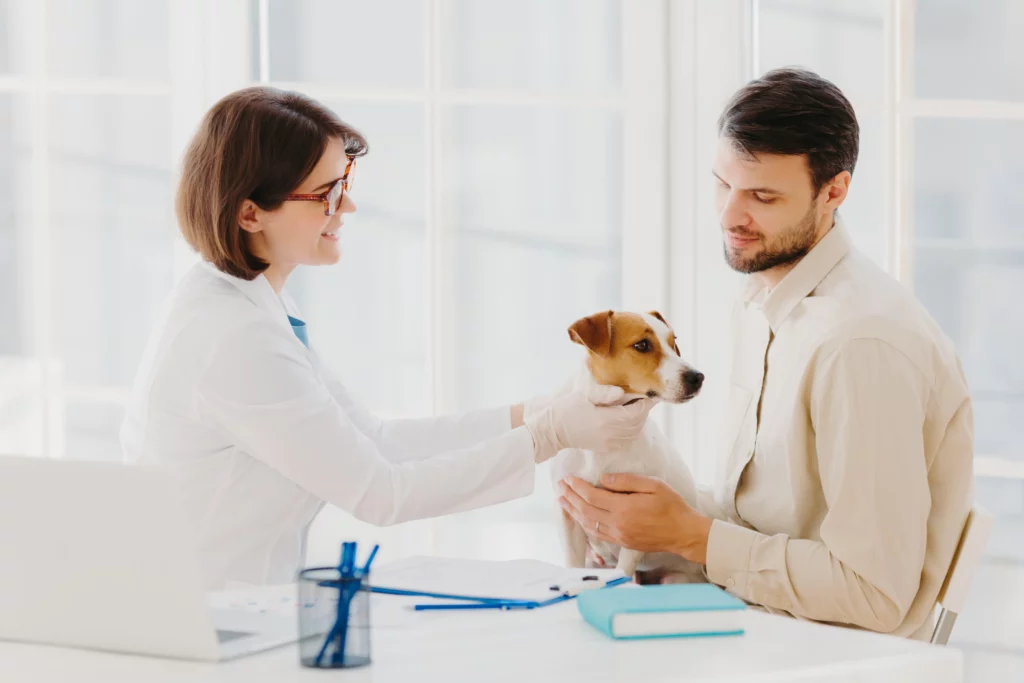
Investing in prevention strategies is crucial for maintaining your dog's long-term skin health and preventing recurring skin rashes. Here are some key strategies to consider:
Regular veterinary check-ups can help detect early signs of skin issues before they escalate into more severe conditions. Preventive care, including vaccinations and routine skin examinations, can help keep your dog's skin healthy and rash-free.
Parasites are a common cause of skin rashes in dogs. Implementing a year-round parasite control plan, including regular flea and tick treatments, can help prevent infestations that lead to skin irritation and rashes.
Pay close attention to changes in your dog's behavior or skin condition, as these may be early signs of a developing skin issue. Frequent scratching, excessive licking, or the appearance of red patches could indicate a skin rash on dogs. Early detection and treatment can help prevent further discomfort and potential complications.
Managing and resolving skin rashes on dogs involves three pivotal steps.
Consistent care and attention are crucial in maintaining your dog's skin health, preventing future issues, and ensuring their overall well-being.
It involves regular vet check-ups, a year-round parasite control plan, and keen observation of your dog's behavior and skin condition for any signs of discomfort or rash development.
To all dog owners, we encourage you to stay proactive in maintaining and improving your pet's skin health. You can help your furry friend lead a happy, healthy, and rash-free life with patience, understanding, and a committed approach.
Remember, the best care is preventative care. Your dog's skin health, comfort, and happiness depend on it. Experience our AniViva® pet series here.
There comes a moment when you start noticing the face of your best friend droopy. As your companion ages, their care changes.
Optimize their health and comfort for their golden years by reading this post and learning how to care for senior dogs.
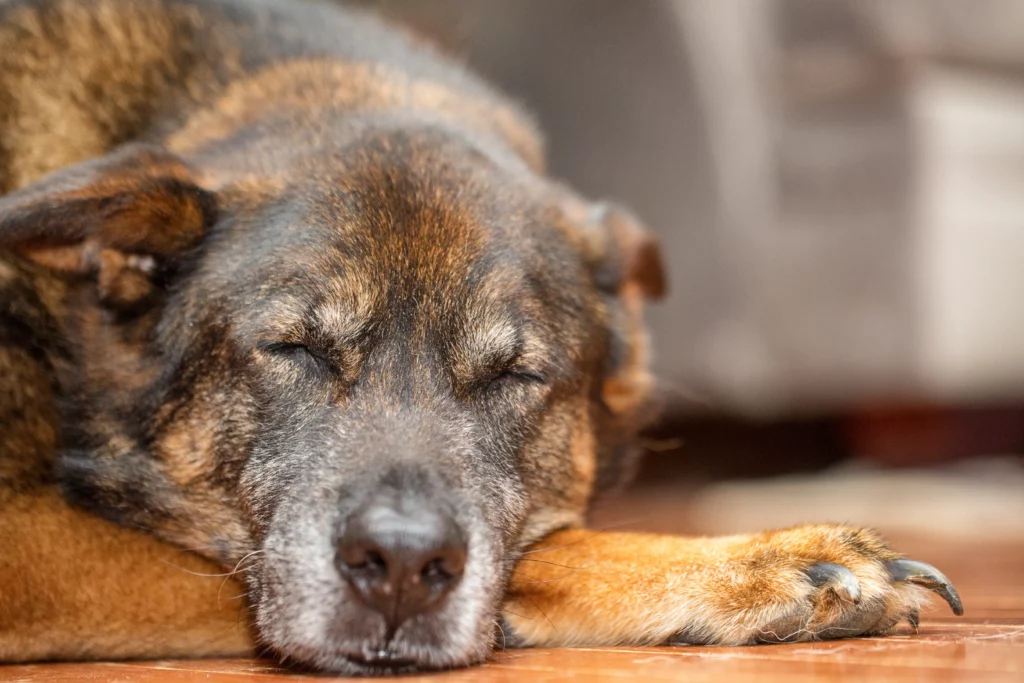
The aging process of each dog differs depending on its individual characteristics - size, breed, genetics, nutrition, and environment play a part in determining how quickly the animal ages.
Larger breeds tend to show signs of seniority much earlier than small breeds;
As your pet dog ages, it may experience a range of degenerative conditions, such as arthritis which can affect its mobility and cause them to slow down.
Even find it hard to walk for extended periods, struggle to move up and down stairs, or have difficulty getting into and out of cars.
Dental diseases at an early age untreated may present problems as they age. Decayed teeth could impair your dog's eating habits and lead to weight loss. Without proper preventive care, senior dogs may even be missing teeth.
Older dogs risk weight gain from declining activities. Age-related metabolism also influences. Access their body condition to determine if
Accessing your pet’s body condition tells you if they are overweight. View their body from above; their waist should be behind their ribs, and the side view of their stomach should tuck up while the ribs are visible. Consider seeking a veterinarian for an accurate examination.
A heavier state fuels health problems like arthritis and heart disease. The guidance of a vet can help determine daily calorie requirements and adjust feeding amounts.
An overview of their health helps to stay on the healthy track. Protect their wellness and provide them comfort as they age.
Change in the pace of senior dogs comes with age, but if they seem stiff or limping - arthritis could be a sign. The breakdown of cartilage in the joints causes pain and inflammation while decreasing movement. Some of the indications of arthritis in senior dogs include:
A forgetful and anxious pet could suffer from cognitive changes.
It's possible that some cognitive decline is an aspect of aging or that other health conditions, such as vision loss, could contribute to the onset of cognitive dysfunction syndrome (CDS) in senior dogs, which is known as the canine equivalent of Alzheimer's disease.
CDS diagnosis focuses on specific behavioral changes, such as house soiling or learning and memory problems, increased anxiety, disorientation or confusion, and nighttime restlessness.
Studies evaluating the biochemical and anatomic components of aging in dogs have indicated some neurological changes that could impact cognitive and behavioral functions. Further research has linked such changes to the accumulation of oxidative damage in brain cells. Specifically, brain cells appear vulnerable to the harmful effects of oxygen-free radicals.
These findings suggest that the biological processes relating to brain aging and behavior in senior dogs may begin as early as 7 to 8 years old.
The advancing age affects the skin and coat health of your pet. Cellular atrophy increases in the epidermis and dermis, and follicles - resulting in hair loss areas. The skin also loses elasticity and is less pliable.
As dogs age, they may experience the loss of melanocytes in hair follicles and a subsequent slowdown in the production of the enzyme tyrosinase.
It may lead to white hairs, often visible around the muzzle and face of elderly dogs.
Moreover, older dogs could have issues with sebum production, leading to scaly skin and a less lustrous hair coat that appears dry and lackluster.
Explore AniViva® Pet Series to enhance the coat health of your best friend.
With age, a dog's reaction time can slow down. Changes in vision, hearing, and olfaction may arise.
In senior dogs, the most common eye change they experience is nuclear (lenticular) sclerosis. It appears as a bilateral bluish-gray haziness in the lens nucleus caused by the increasing density of lens fibers and the refractive index.
Though sometimes mistaken for cataracts, nuclear sclerosis often does not affect a dog's vision - except in severe cases. It is common for aging dogs to experience gradual night vision loss; however, many owners and veterinarians overlook this symptom until diminishing hearing sets in, highlighting the importance of hearing over vision in dogs.
Vision Loss in Old Dogs
Age-related hearing loss caused by cochlear degeneration is a common issue for old dogs, and it can look similar to what humans experience. This hearing impairment typically does not present any direct health risks, but owners may worry about their dog's safety and well-being. In some cases, age-related changes in cognition can cause hearing loss.
Hearing Loss in Old Dogs
A professional examination of your pet will help for better assessment and proper care.
Urinary incontinence is the weakening of muscle controlling the bladder’s opening. An old dog might go during the night, dribble while walking, or fail to hold it in as before.
Medication or an increase in bathroom breaks might help. Worst-case scenario, they have to use a diaper.
Other possible causes exist, such as urinary tract infections or bladder stones, and visiting your vet will help with diagnosis.
Be aware of kidney disease too. It happens when kidneys no longer filter waste products from a dog’s blood, increasing water intake and thus more urine.
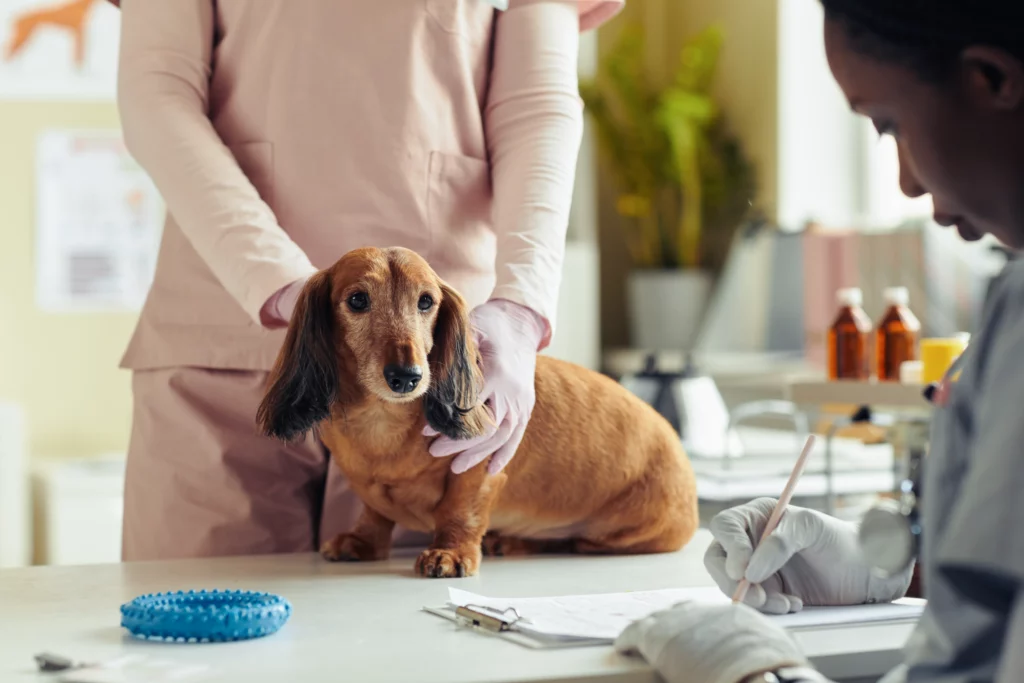
As dogs age, they may experience several health concerns affecting their quality of life. Owners need to be aware of these issues and take steps to ensure their dog stays healthy and happy well into their senior years.
If you liked this article, we suggest you read 6 Easy Steps For Dog Grooming at Home.
Discover why our products are top-of-the-line and how they can nourish your pet’s skin health.

Did you know that cats can get dandruff too? Just like humans, their skin can become dry and flake when petted. While it's usually not a symptom, figure out the root cause to provide the best treatment. In most cases, helping your cat skin dryness takes a few easy steps.
Cats' dry skin can be a sign of dietary deficiencies. Omega-3 fatty acids and zinc are necessary for a balanced diet that will help maintain healthy skin and coat.
Dry skin may factor in due to an overweight cat or mobility problems that prevent adequate grooming. It can lead to hair matting, inflammation, and flaking. Regular exercise and nutritionally balanced meals can help prevent this.
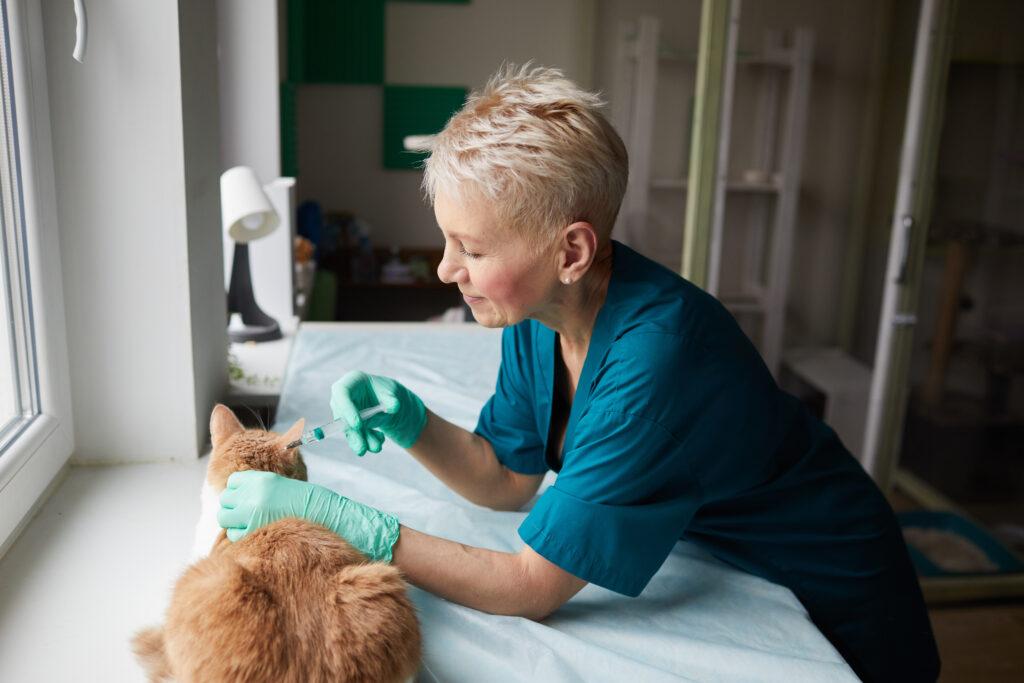
Is your cat's fur lackluster? Are you seeing white flakes in their coat? These could be signs of dry skin. Other symptoms include excessive scratching and a lack of shine to the fur.
Does your cat have an itch it can't seem to scratch? Dry skin could be the culprit! Itchy, inflamed skin is a common symptom and can often link to dermatitis.
On top of this, cats suffer from dry skin and often show signs of dandruff - small white flakes in their fur. While usually not serious, if you see this in combination with other symptoms, a bigger underlying problem might be at hand.
If you observe your pet scratching itself frequently, it may be experiencing some irritation from its skin. It can manifest as a patchy coat or baldness, so keep an eye out for any significant changes to the texture and appearance of your pet's fur.
It is important to note that if your cat is continuously licking at its skin, the problem might be more severe than dryness - ask your vet if you notice particularly concerning behavior.
Cat skin dryness can indicate something else - allergies, infections, and parasites can all contribute to flakiness, itching, and unkempt fur. You may also notice your cat self-grooming more often than usual. The key to helping your pet is to identify the underlying cause of the dry skin and provide appropriate treatment.
In colder months, the dry air of a heated environment can lead to dehydration. During the summer, sensitive skin may become dried out when exposed to air conditioning machines. Furthermore, cigarette smoke, fragrances, and household chemicals may influence your cat's uncomfortable skin condition.
Use humidifiers throughout the house to increase the overall humidity levels. Keeping your cat well hydrated is also essential for internal hydration and will support a healthy coat.
When bath time rolls around, choose shampoos and conditioners that are specially formulated for cats and designed to be moisturizing. It can aid in combating dry, itchy skin.
Excessive skin and hair buildup on the coat can cause dry, unhealthy skin. Cats with limited mobility, such as arthritis or obesity, can’t groom themselves properly.
Regular brushing may prevent excess fur from accumulating and trapping moisture close to the cat's skin.
If your cat's inability to groom is related to obesity, consult your veterinarian about crafting a plan that helps them lose excess weight. Taking this step not only allows them to groom themselves better but will overall benefit their health.
When the problem is due to arthritis or any other medical condition, your vet will devise a treatment plan tailored to that specific case and may also provide medication for pain management.
Excessive grooming can also lead to dry skin and hair loss. Cats generally itch or feel uncomfortable when over-grooming to reduce the sensation.
Cats don't need regular baths - unless they are dirty or have a skin issue. While occasional bathing with a cat-safe shampoo may be alright, frequent baths can lead their skin to become dry.
Treatment
The ideal way to treat dry skin caused by frequent bathing is to reduce the frequency of baths. If your cat has a medical condition that hinders their grooming process, speak to your veterinarian about what bathing routine will suit them without making their skin and coat oil-deficient.
Home-prepared diets may be well-intentioned but don’t provide balanced and complete nutrition. Even commercial food products could prove ill-suited for some cats. Generally, cats do best on moist foods high in protein and low in carbohydrates.
Introduce a high-quality, well-balanced diet. Consult with your veterinarian concerning the best quality commercial foods for your cat. If they lack nutrients, it's advisable to have them assessed and get your vet's advice on the correct meals.
Parasites:
External parasites like fleas or mites on the skin may cause the skin to develop a dry, flaky appearance. In some cases, fleas and flea dirt are visible to the naked eye, but fastidious cats may remove evidence of fleas while grooming. Most mites aren’t evident. Cheyletiella mites are an exception and are often called "walking dandruff."
Allergen exposure can prompt a cat's immune system to respond in the form of itchy, inflamed, and dry skin. Possible allergens include pollen, dust mites, food, chemicals, and fragrances.
Bacterial and fungal infections are common contributors to this issue, and if left untreated, the condition may worsen over time.
Treatment for a cat's skin disease will depend on whether it is bacterial or fungal. Antibiotics are prescribed for bacterial infections, while the antifungal medication is the go-to for fungal ones. These medications can be taken orally or applied topically.
Systemic diseases, hyperthyroidism, diabetes, kidney disease, or heart disease can cause skin issues. For some, it may directly affect the skin's appearance. Even when this is not the case, cats that suffer from these conditions might not be able to groom themselves properly, leading to a dry, flaky complexion.
A veterinarian must diagnose and evaluate before determining the most suitable treatment option for hyperthyroidism in an individual cat. Various treatments are available, including medications, radioactive iodine therapy, surgical procedures, and dietary adjustments.
Seeking help leads to a good prognosis. Otherwise, health complications may arise.
Stress also affects the skin and coat of cats, just as it does on humans. Various situations can be distressing, such as moving to a new home, welcoming a new family member or pet into their environment, noise from outside the house or other events, and sickness.
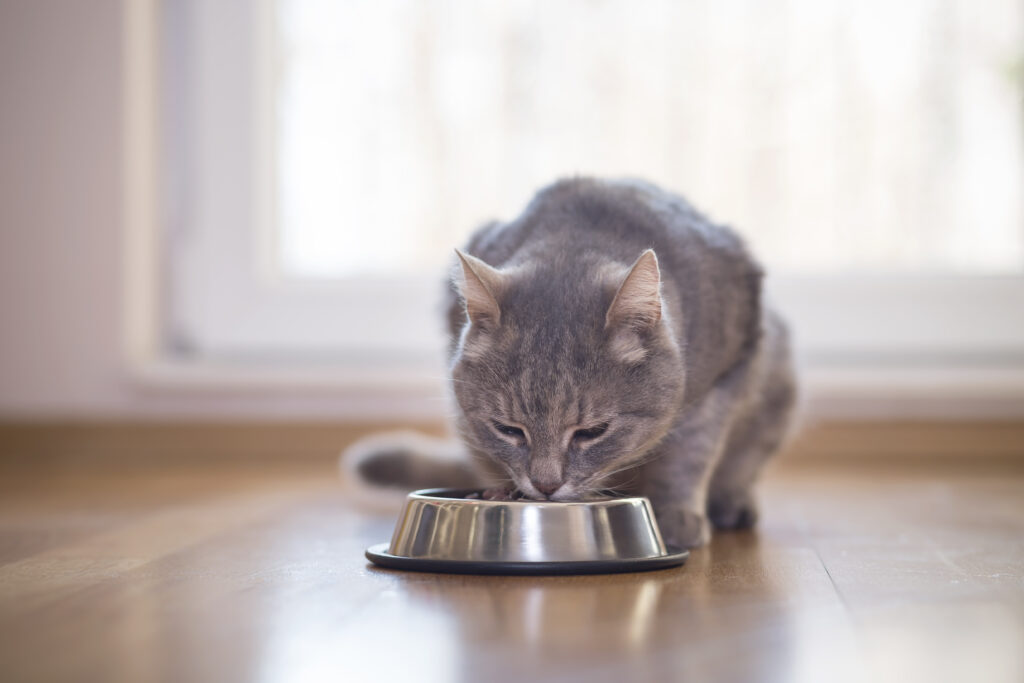
After reading through the causes of cat skin dryness, it’s your turn to attend to your cat. Casual grooming sessions to examine their fur are encouraged, but remember that overdoing it can lead to much more discomfort and dryness.
As a pet parent, learn the health hazards your feline friend could experience. Doing so will help prevent or prepare you for addressing the underlying issue.
Do Cats Need Baths? Read here.
Our cosmetic skin conditioner and moisturizer promote animal health through its Zinc-Copper-Magnesium concentrated formula. Your pets will look and feel their best with AniViva! View our products here.
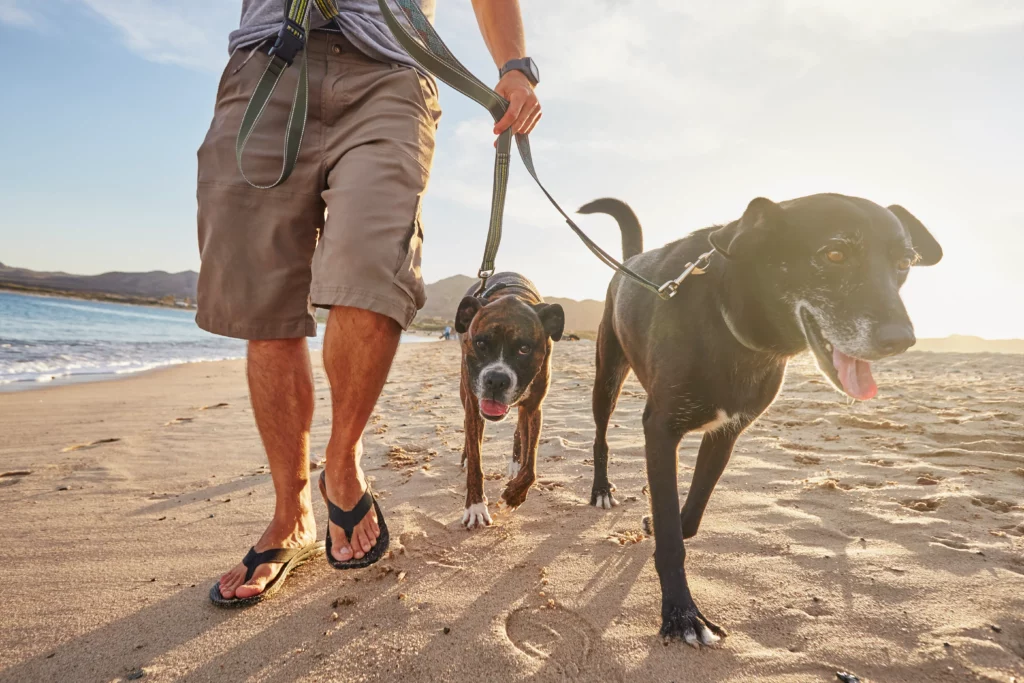
Taking your dog to the beach sounds like a dream come true; it’s fun to watch their happy face at the scenery of the ocean. But not all breeds look forward to a sandy day.
Before hitting the spot with your best pal, ensure they can swim - e.i. Basset hounds can’t swim.
If they pass the swimming test, your pet will be in for a treat; the beach may provide a new experience, sounds, and smells, along with some fun games!
Maximize the outing with this insight into activities, training behavior, and preventions.
Before jumping on your beach adventure with your four-legged friend, there are a few things you need to do to prepare.
Follow these recommendations to enjoy the beach without any unexpected hiccups.
Pack the Essentials
Gather a bowl for water, food, treats, toys, towels, and poop bags. Check the weather and consider bringing a cooling mat or vest to keep your pup comfortable.
Check Leash Laws
Different beaches have different rules when it comes to dog to the beach. Some may require keeping your dog on a leach - yikes! While others may allow off-leash play in designated areas. Research the rules of the specific beach before visiting.
Prep Your Dog
Is it their first time, or are they a little rusty since the last time? It's a good idea to prepare them ahead of time. Practice basic obedience commands like "come" and "stay," getting them used to walking on sand and encountering new smells and sounds.
Consider Sun Protection
Just like humans can get sunburned, dogs can too! If your pup has short hair or light-colored fur, consider applying pet-safe sunscreen before heading out. Find a shaded spot or bring your artifact to have shade, improving the adventure without getting sunburned!

Do fun activities with your best friend to make the most of them at the beach!
Keep an Eye on Your Dog
While it can be tempting to let your dog off-leash and run free on the beach, monitoring their being will help them not to get into dangerous situations or bother other people or dogs nearby.
Provide Plenty of Water
Dogs can get dehydrated quickly, especially in hot weather. Bring enough water for both you and your pup and offer it frequently throughout the day.
Playtime!
The beach is a great place to play games with your dog! Bring toys like frisbees or balls and play fetch in the water or sand. Remember to stay close to the shore if playing in the water.
Go for a walk
Adventure on shore, let your best pal feel the sand, and waves, take in the scents and watch crabs.
Build sand castles
Then record how your dog destroys it with a smile on its face.
Get on a boat!
Witness the immensity of the ocean riding a boat and take your canine friend to enjoy the view as well.
Take Breaks
Even if your dog seems restless, take plenty of breaks throughout the day to not get overtired or overheat. Find a shady spot to rest and relax together.
Be Mindful of Others
Remember that not everyone loves dogs as much as you do! Be respectful of other beachgoers by keeping your dog under control and cleaning up after them if they go potty on the sand.
To ensure your visit to the beach goes great, prepare your dog with basic obedience training, either verbal or hand signals.
If your dog isn’t ready for that type of freedom, stick to keeping them on a leash and enjoy a walk on the beach.
A top command would be, “leave it” since your dog might be interested in eating things it finds on the beach, trash, dead fish, or somebody else’s food, “leave it” helps to communicate they can’t proceed.
What’s your dog’s personality? Are they social butterflies or shy and aggressive with others? Pick a day, time, and spot that suits the attitude since beaches can get busy, and it’s about having a good time and not spending too much time monitoring them.
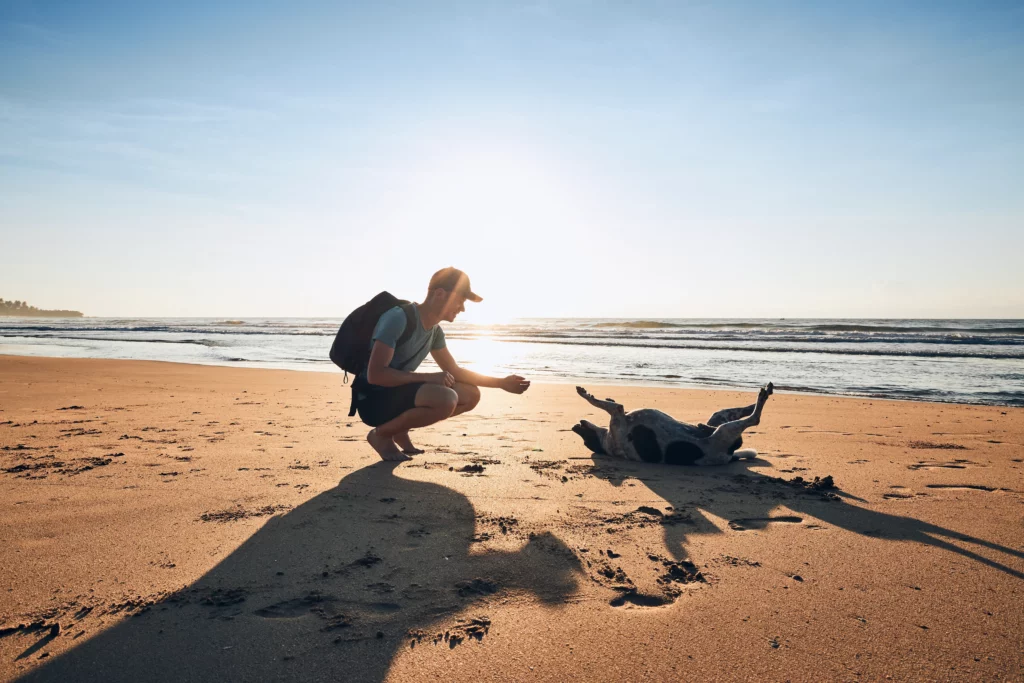
After a fun day at the beach, do your part in keeping the beach clean and safe for everyone.
Remember some tips for cleaning up after your dog:
Bring Plenty of Poop Bags
Make sure you bring plenty of poop bags to the beach so that you can clean up after your dog if they go potty on the sand.
Use Designated Trash Bins
Most beaches have designated trash bins where you can dispose of your dog's waste and any other trash you may have accumulated throughout the day. Use these bins instead of leaving trash or waste on the beach.
Leave No Trace
Pack up your belongings and any trash or waste before heading out.
Consider Participating in a Beach Cleanup
It is a great way to give back to your community and help keep our beaches clean and beautiful for everyone.
You'll be doing your part in keeping the beaches clean while setting an example for others visiting with their dogs too.
Taking your dog to the beach can be a fun and rewarding experience.
Always prioritize your dog's safety by keeping them on a leash when necessary, providing plenty of water and shade, and monitoring their behavior around other people and dogs. And clean up after them so that the beaches can remain clean and beautiful for years.
With planning and consideration, ensure that your day at the beach is enjoyable for everyone involved. So pack up those towels and toys, grab the sunscreen, and hit the sand with your canine best friend!
After a walk on the beach, a quick grooming session with our AniViva® Serum will enhance your pet’s coat to be shiner and healthier.
Soft to the touch, pamper your pet love with the best pet cosmetic to ensure good health.
If you liked this article, you should read The 5 Top Recommendations For Hiking With Your Dog!
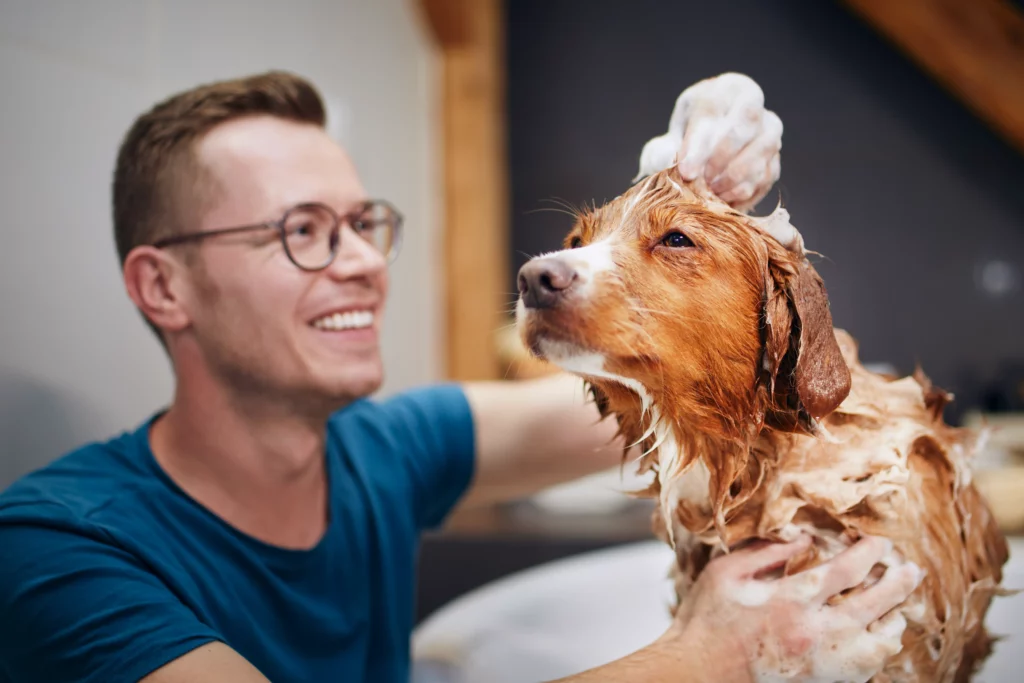
Don’t wait until your dog hits the pet salon to enhance their health and beauty. Dog grooming at home can help examine their overall health and track any signs of problems.
How often should you groom your dog? The answer depends on their size, breed, and type of coat.
Regardless of the breed, hygiene practices such as teeth brushing, ear cleaning, nail trimming, and brushing are essential to regular dog care.
If you got a puppy, take the opportunity to introduce them to certain grooming habits at an early age so they can build trust and know you aren’t going to hurt them because nail trimming can be terrifying!
Not to mention, it is the bonding time that strengthens your relationship with them. Once you start practicing home grooming, stick to a predictable schedule and system. Your dog relies on you to take charge and on your behavior. Therefore, regular grooming lets them get used to being touched in sensitive spots, and rewarding them for their positive behavior will help associate grooming as a good - making the experience for both easier!
Follow a series of steps that allows you both to reach a comfort and confidence level!
Besides having a dashing good boy/girl? Dog grooming at home and professional grooming visits will ensure your dog’s health.
And when their coat, nails, teeth, ears, paws, and eyes are clean, they will be more irresistible to love! A true benefit for your best friend - and your household.
Learn more by reading The importance of Pet Grooming - 5 Crucial Recommendations.
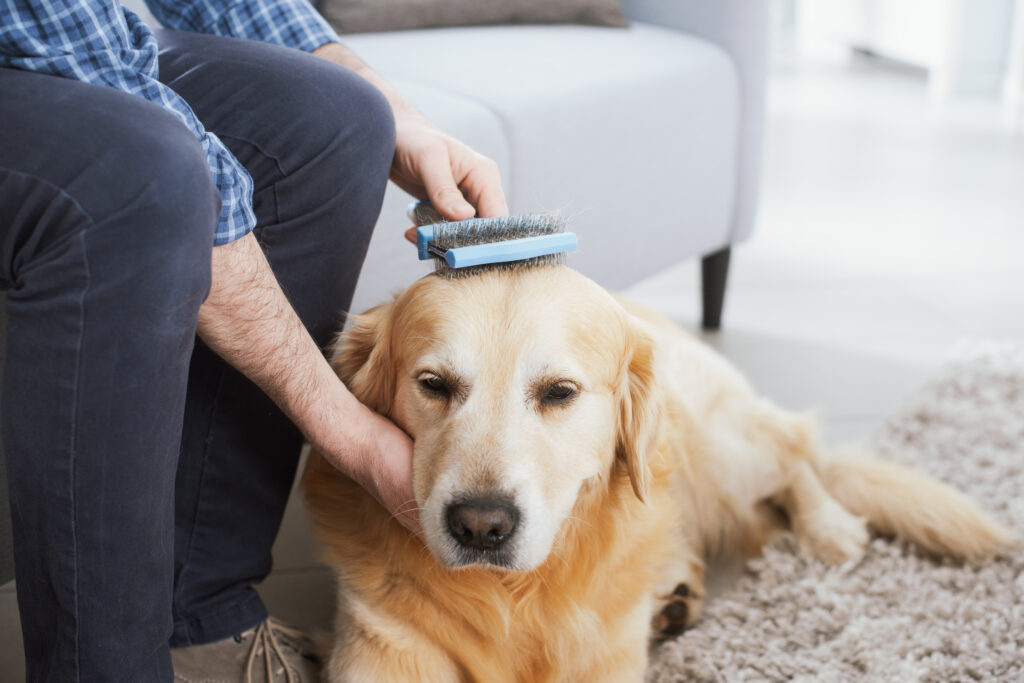
It’s all in the brush. The first step to purchasing the correct tools is identifying your pal’s coat texture and length. You can’t buy whichever is in your local store.
Longhaired breeds need pin brushes - long, rounded-ended stainless steel or chrome-plated pins.
Short & medium (and some long-coated breeds) need bristle brushes.
Slicker brushes remove mats. There are also curry combs to polish smooth coats and remove dead hair. Other equipments that can serve you are; clippers, stripping knives, rakes, and hairdryers.
As you brush, check for burrs and mats that form behind the ears and under the legs. Examine any cuts or scrapes on their skin.
Did you know that regular brushing can help keep shedding under control?
Regular baths are ok, but too frequent baths can remove natural oils and affect the coat by becoming dry and harsh.
If you’re unsure what best suits your pet, ask a veterinarian.
Before filling a tub or basin, place a towel underneath to avoid slips. Bring in your pet’s favorite toys if needed. Place cotton balls in their ears; a few drops of mineral oil in their eyes - now they are ready to get wet!
Use warm water and apply a mild shampoo formulated for dogs. Lather the neck and back; after much gentle scrubbing, rinse thoroughly with warm water. Pad dry with a towel and seek cover for when they shake.
If your dog isn’t frightened by the blowdryer, by all means, use it in low mode with little heat. After a bit of drying, brush your dog to finish bathing your dog.
If your best friend is walking and you hear that clicking on the floor, it is time for a nail trim. Long nails interfere with your dog’s gait causing walking to be awkward and painful. Maintain their health by frequent trimming.
Cutting nails isn’t an easy job. If your dog is grown and not used to getting their nails trimmed, it could be a circus show for you. Be patient and try to ensure them you aren’t going to hurt them. Gently trim a nail or two for your dog to trust you.
Early grooming can help your dog feel more comfortable in this situation. Attentiveness is fundamental to not causing an injury. Remember to buy designed clippers for dogs. These have a safeguard to protect the nail from being cut too short. Clip the hook-like part that turns down.
Once a month, clean your dog’s ear, more if they are prone to ear problems - but seek that veterinarian's help before making drastic life choices.
Do not dare stick anything in their vulnerable ears! You will only clean the outer part using a damp cloth or cotton swab soaked in mineral oil.
Drop irritating components! Your dog’s eyes are sensitive. Therefore, a moist cotton ball can help clean surrounding discharge.
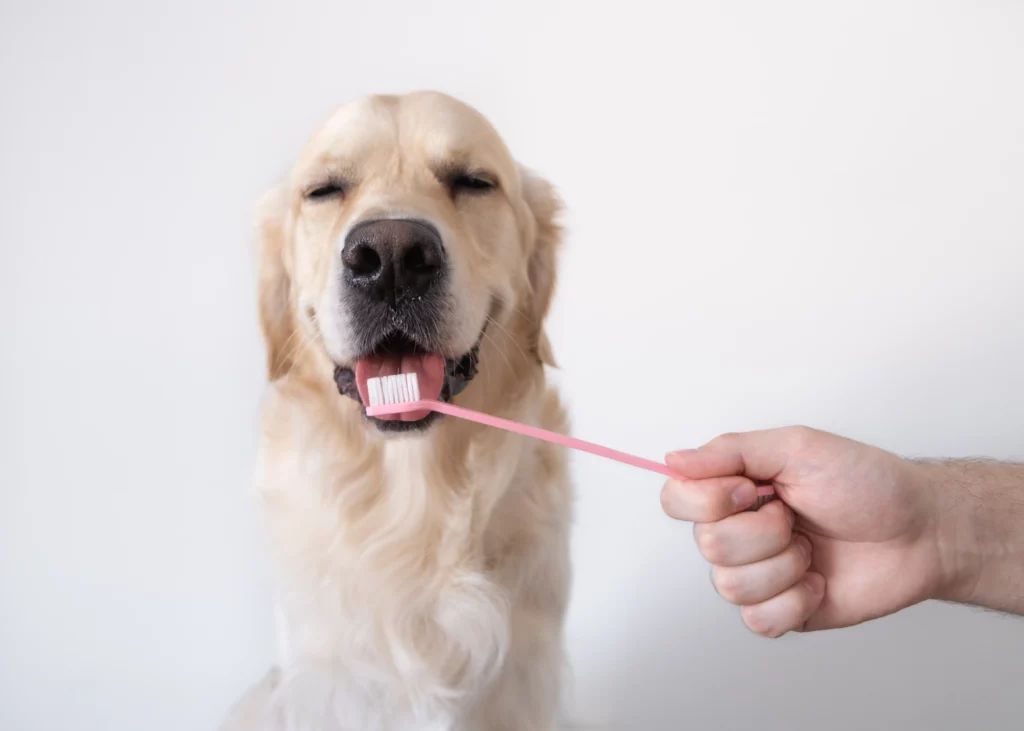
There are special toothbrushes and toothpaste for your best friend. If it’s your first time, work up the courage to use your fingers to rub their gums and teeth before introducing the toothbrush.
Chew toys are available to help their dental health. And aging dogs tend to have tartar buildup that requires special cleanings by a veterinarian.
Schedule some time to have a spa day with your pet. Assure them you care for their well-being by practicing hygiene habits together.
It may sound like a lot of work, but the reward is seeing them shine and feel comfortable, thus, providing you with more memorable experiences.
Besides bonding, dog grooming at home gives you insight into their health, and timing is everything when it comes to issues.
A formulated spray enhances their coat’s health by providing essential minerals and vitamins that can protect their skin. Discover the different presentations of this unique pet care product.
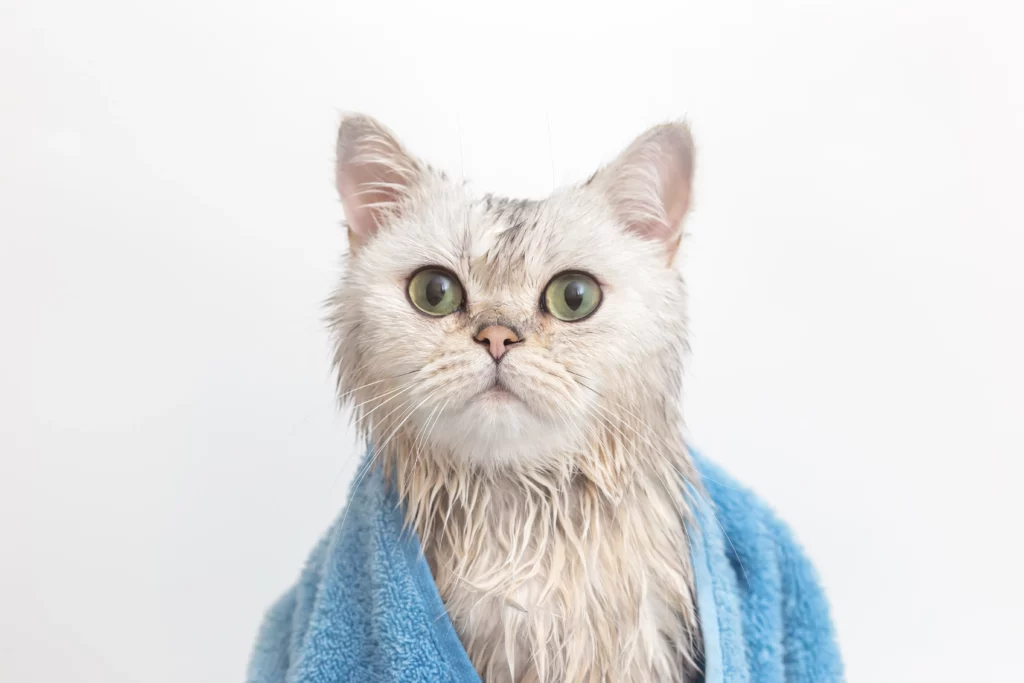
Cats do not need regular baths like dogs or other animals; cats are good at grooming and keeping their fur clean - free of dirt and debris.
Overbathing strips the natural oils from their skin and coat, leading to dryness, irritation, and inviting health problems.
However, there are certain situations where a cat may need a bath, such as:
Overview, if your cat spends time outdoors exploring and getting into messy situations, it may need an occasional bath to remove dirt, mud, and other substances from its fur.
Some might have the urge to frequent baths because of allergy relief from dander. Some research suggests that a protein in cats’ saliva is the primary cat allergen - grooming sheds it into the environment. Instead, opt for cat food that helps reduce the allergen.
The general rule is to consult your veterinarian before bathing your cat to ensure it is safe and appropriate for specific needs.
It is vital to use a gentle, cat-specific shampoo, avoid getting water in their ears and make the experience as stress-free as possible.
Learn about 4 Dreadful Causes of Dermatitis in Cats.
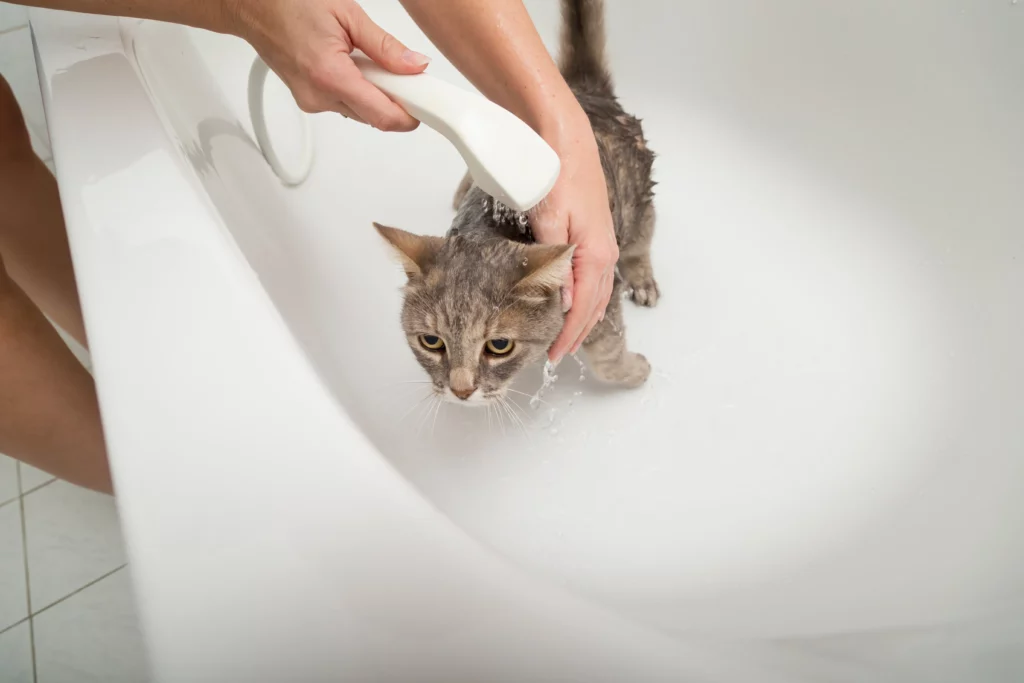
As mentioned previously, certain situations require bathing time.
Infections: Regular baths can help prevent flea or tick infestations in your cat's fur. Fleas are uncomfortable for your cat and may lead to skin irritation and other health issues.
Allergens: Some cats have skin allergies that cause excessive itching, scratching, and dryness. Giving them a soothing oatmeal bath can help relieve these symptoms and promote healing.
Skin Health: Bathing your cat can help identify skin problems such as infections, rashes, and hot spots.
Odor Control: Litter boxes, food, and rolling in the dirt may arouse a foul odor. Bathing your cat can help them smell fresh.
Bonding Time: Although it may not feel like the brightest idea - at first - it can help you establish trust and build a stronger relationship with your furry friend.
Medical conditions: Ringworm or mites, bathing may be necessary as part of its treatment plan.
Outdoor adventures: Keen to strolling out? Your cat may need an occasional bath to remove dirt, mud, and other substances from its fur.
Showing: Is your pet a competitions or exhibitions star? Regular baths with special shampoos can help keep its coat looking shiny and healthy.
Other reasons your cat may need a bath
Are you concerned about tapeworms in cats? Read 4 Ways to Prevent Tapeworms in Cats.
In most cases, it is ok not to bathe a cat. As mentioned earlier, cats are typically clean animals that care for their grooming needs. They can keep themselves clean by licking and grooming their fur.
Regular bathing is not for most cats, as it can remove natural oils from their skin and cause dryness or irritation. Furthermore, many cats find the experience stressful and may become agitated or scared during bath time.
However, there are certain circumstances where a bath may be necessary for your cat's health and well-being - flea or tick infestation or skin allergies. In these cases, follow proper bathing techniques and use a cat-specific shampoo.
The frequency of baths depends on several factors, including breed, age, and health status. Most cats do not need to feel the bubbles more than once every few months or as suggested for treatment.
Frequent baths and harsh chemicals may lead to dryness or irritation since the natural oils strip off.
On the other hand, some breeds of cats - long hair or thick coats - may require more regular baths to prevent the matting and tangling of their fur.
If you have concerns about your cat's hygiene or skin health, it's always best to consult with your veterinarian for advice on the best approach.

Like adult cats, kittens can keep themselves clean with their tongue and teeth.
Nonetheless, these same exceptions of adult cats and kittens may apply.
Bathe if needed:
Kittens are more delicate than adult cats, so be extra gentle when handling them during a bath.
Bathing a cat can be challenging; submerging cats in water feels like torture. However, accomplish the task with a gentle approach and patience.
Follow these steps for success:
You will need a cat-specific shampoo, a large towel, a cup or pitcher for pouring water, and possibly some treats or toys to keep your cat calm.
Choose your arena:
Select a warm room with no drafts or cold air currents. Cover the floor with a non-slip mat or towel, and close any doors or windows to prevent your cat from running away.
Fill a sink, bucket, or bathtub with about two to three inches of lukewarm water (not hot). Place a rubber mat on the bottom of the tub or sink to prevent your cat from slipping.
Brush your cat's fur:
Multi-task by filling up the water and brushing your cat in a separate room. Set a timer or any reminder to close the faucet. Remove any tangles or mats before wetting their fur for easier washing and prevent any discomfort.
Wet your cat:
Use a cup or handheld showerhead to soak your cat's fur, avoiding their face and ears as much as possible.
Shampoo time:
Apply a small amount of cat-specific shampoo onto your hands and massage from the neck to the tail - no need to be rough. Avoid getting shampoo in their eyes, nose, or mouth.
Rinse:
Use clean water to rinse off all the shampoo from your cat's fur until no more soap suds are left.
Dry off:
Wrap your cat in a towel and pat them dry, do not rub too hard, which could irritate their skin. You can also use a hairdryer on the lowest heat setting if your cat doesn’t freak out from the loud noise.
Treats! For your cat and yourself:
Once your cat is dry, reward them with treats, toys, or cuddles to help them associate bath time with positive experiences. And pat yourself on the back for not losing your patience.
Be mindful of cats not enjoying baths, monitor their behavior throughout the process, and stop if they become agitated or uncomfortable. Bathing can become an easygoing experience for you and your feline friend.
If your cat is particularly anxious or aggressive, it may be best to consult a veterinarian or professional groomer.
Apply a nutritional spray to pamper your four-legged friend. It will boost their skin health!
What makes AniViva® efficient? It is a cosmetic skin conditioner and moisturizer with a Zinc-Copper-Magnesium concentration that aids fur health and skin concerns.
Watching your dog scratch all the time may be alarming. Itchy skin in dogs raises concern about fleas, but is it seasonal or chronic? Severe itching in dogs is unpleasant, but you can help your best friend by addressing the issue.
Besides your typical-constant itch, your canine friend might show other indications of discomfort:
Pruritus is another term to describe it. Typical causes of pruritus are
Itching is not a diagnosis or specific disease but could enclose a threatening illness. Many skin diseases don’t cause itching at first contact. It may develop because of bacterial or fungal infections, and in some cases, itching occurs after the initial cause is past.
Read 6 Most Common Skin Allergies in Dogs to learn about allergens.
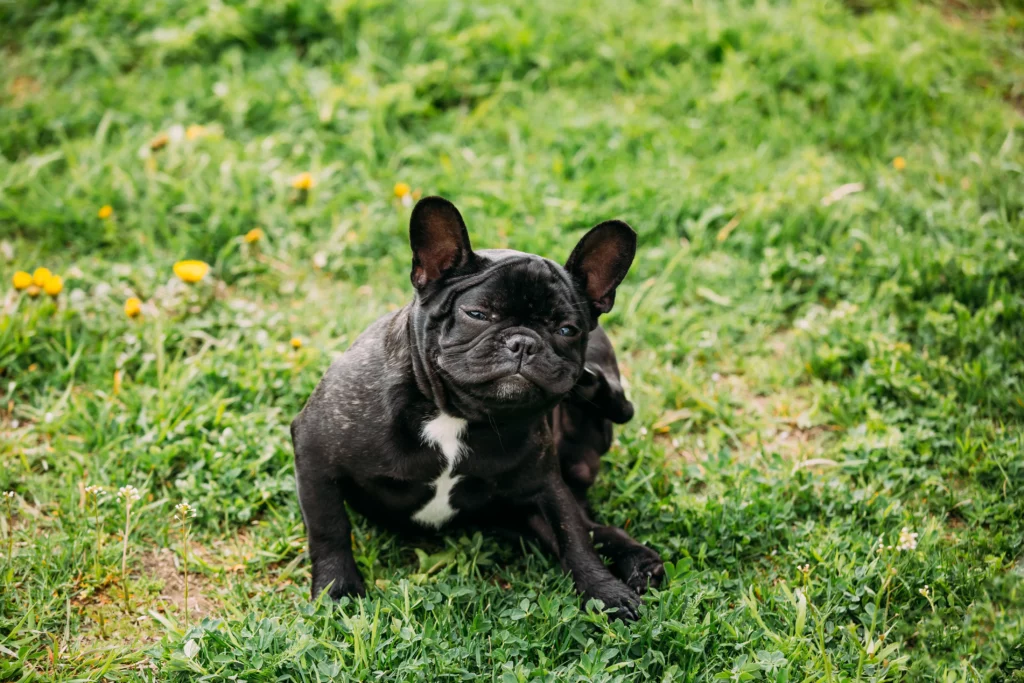
Dogs can get sniffles just like humans do during seasonal changes. Still, these allergies present as itch and red skin rather than constant sneezing and irritable runny nose and eyes.
Ragweed or fleas may spring allergies in your canine during high peaks. Your pet might experience an itch for weeks to a few months each year.
Seasonal itching, also known as allergic dermatitis, is an acute condition caused by seasonal allergens such as pollen, dust mites, and mold spores that affect the skin and cause a dog to become itchy.
Symptoms include scratching, biting, or licking the affected area, redness and swelling, hair loss, and even bald spots.
Treatment for seasonal itching typically involves reducing the dog’s exposure to allergens through bathing, applying topical medications or corticosteroids, and feeding a hypoallergenic diet.
Unlike the temporary breaks seasonal itch may have, chronic itching in dogs is continuous. Common causes include food allergies or an environmental allergen - mold or dust mites.
Chronic itch in dogs is unremitting scratching, biting, or licking of the skin; and can be caused by different factors such as allergies, parasites, skin infections, hormonal imbalances, or other underlying medical conditions.
Treatment of chronic itch involves identifying and treating the cause while providing relief from the itching through medications and lifestyle changes such as bathing with a specially formulated shampoo or applying an anti-itch cream.
A good coat conditioner may also reinforce to help your dog from skin issues. Click to discover The Best Skin and Coat Conditioner for Dogs.
In some cases, the chronic itch manifests by a food allergy or intolerance, and switching to a hypoallergenic diet may provide relief.
A diet trial will help confirm or exclude a food allergy. Your trusted veterinarian will specify a diet that doesn’t include the usually consumed foods. During the testing, you must do your best to avoid interrupting the diet - not rewarding it with treats or compromising foods.
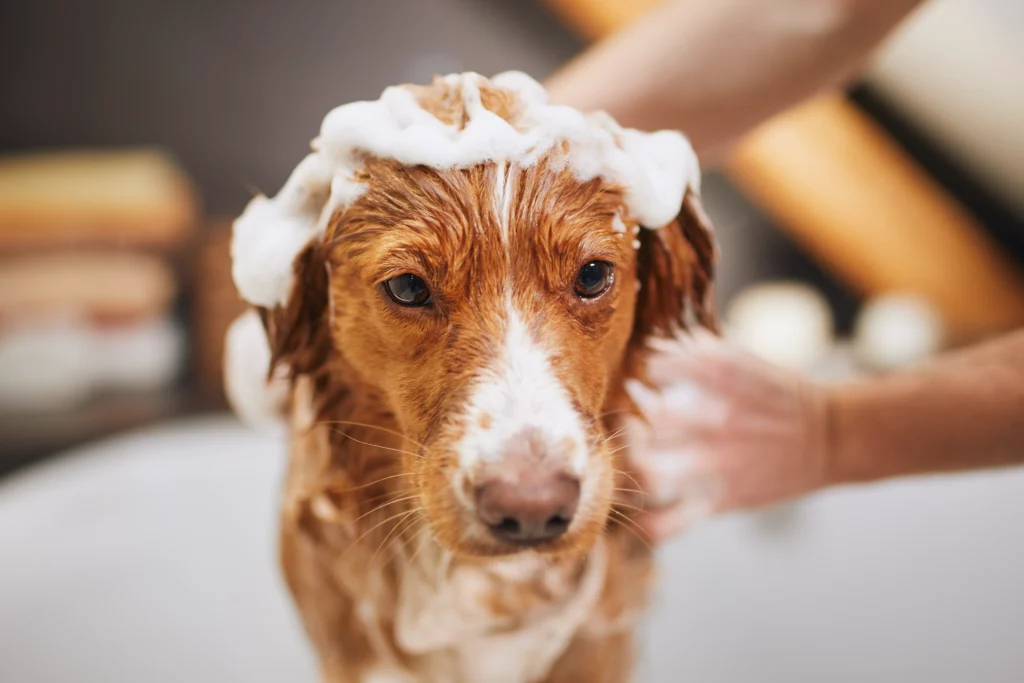
Medicated topicals and shampoos are available. Dietary supplements may also help treat itchy skin in dogs. Each serves the purpose of helping reduce inflammation or discomfort, while others tackle the underlying cause of itching.
Don’t self-diagnose your friend! Consult a professional for safety and better results.
Lifestyle changes should need to come underway. Reduce the stress levels your pet might experience, spend some quality time with them, go for a walk, or play. Help them be their best selves with regular exercise and a balanced diet. It will strengthen their skin’s natural defenses.
Common treatments prescribed by a vet:
Different factors may cause itchy skin in dogs. For that reason, it is vital to monitor your dog’s skin routinely to identify any underlying medical conditions early.
Learn more about The Importance of Pet Grooming - 5 Crucial recommendations to practice hygiene and keeping your pet safe!
Seasonal itching may require reducing the pet's exposure to allergens, while chronic itch needs more comprehensive treatment such as medications, lifestyle changes, or dietary modifications.
If your canine companion is scratching excessively, it is best to consult your veterinarian to determine the cause and discuss appropriate treatment options. With timely diagnosis and effective management, you should be able to keep your furry friend comfortable and free from itchiness throughout their life.
After the scare, treat your pet with AniViva®. It is easy to spray on and offers nutrients. Boost their skin health and improve the shine and softness of their fur. AniViva® delivers all-natural and environmentally friendly solutions. It contains zinc-copper-magnesium to help ease heat rash, dull coats, or skin health issues.
Experience AniViva® to enhance your dog’s wellness!



